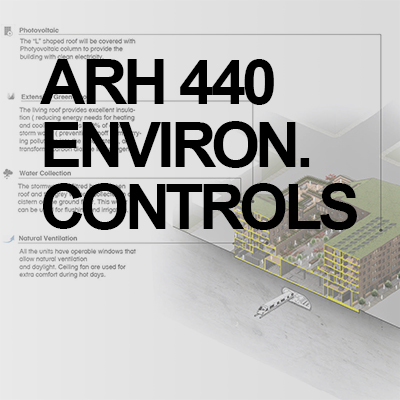
ARH 440 Environmental Controls Systems
Learn the fundamental concepts of heating, cooling, plumbing, and ventilation in buildings to conserve our valuable natural resources. You’ll explore ways to increase human comfort using efficient systems, optimal site orientation for different climates, and effective building envelope systems. (cross-listed with ARH 605)
Prerequisites: ARH 320, ARH 330, ARH 350, ARH 399, ARH 430, ARH 441 (ARH 440 and ARH 450 must be taken concurrently)
Energy Analysis Software Required: Climate Consultant, Climate Studio, Autodesk Forma
Course Learning Outcomes
- Document evidence-based decision-making processes used to incorporate feedback
- Generate and interpret climate data visualizations for project site and use diagrams to visually explain the correlation to design parameters
- Compare different building massing and orientation options and their respective energy conservation levels using energy modeling tools
- Integrate environmental controls systems in the design of a building using clearly stated design and performance criteria
- Integrate envelope systems and assemblies using clearly stated design and performance criteria
- Provide continuity of insulation and moisture barrier in envelope assembly
- Integrate life safety systems in the building design
NAAB Criteria
- This course addresses part of NAAB SC.1 Health, Safety, Welfare in the Built Environment (Understanding): How the program ensures that students understand the impact of the built environment on human health, safety, and welfare at multiple scales, from buildings to cities
- This course addresses part of NAAB SC.3 Regulatory Context (Understanding): How the program ensures that students understand the fundamental principles of life safety, land use, and current laws and regulations that apply to buildings and sites in the United States, and the evaluative process architects use to comply with those laws and regulations as part of a project
- This course addresses part of NAAB SC.4 Technical Knowledge (Understanding): How the program ensures that students understand the established and emerging systems, technologies, and assemblies of building construction, and the methods and criteria architects use to assess those technologies against the design, economics, and performance objectives of projects
